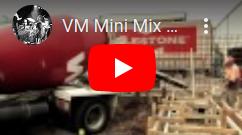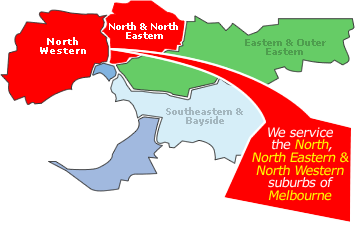Placing, finishing and jointing concrete
How should I place concrete?
Flat, Even Sites
Start placing concrete at the furthermost corner of the formwork from where the concrete is mixed or delivered; work towards the source of concrete supply, never away from it.
Always place new concrete into the face of concrete already in place. Be careful not to damage or move the formwork. Avoid damage or movement of steel reinforcement.
Sloping Sites
Start placing at the lowest point, working upwards to the highest point. Pre-plan how concrete will be supplied to the site; where it is mixed or delivered.
If attempting to place a large area of concrete where the gradient is steep and/or site access is difficult, pumping the concrete may offer the most practical solution in terms of time, energy and convenience.
IMPORTANT
If placing concrete directly from a truck or concrete pump, place concrete vertically into the face of concrete already in place. Never allow the concrete to fall more than 1 to 1.5 metres.
You must compact concrete during placement.
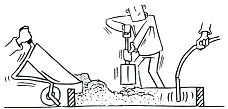
How should I compact concrete?
Compaction is a necessary part of concrete placement and must be done while concrete is in a workable (plastic) state. Compaction is the first step to ensuring that the hardened concrete will be strong and durable.
For most small household projects, compact by first working the concrete well into the formed area, particularly alongside the formwork, with a spade or shovel as the concrete is progressively placed. Use a spade or shovel in poker action to consolidate the concrete to a consistent depth throughout the entire job.
The second step in the compaction process is tamping the placed concrete with a screed board. A screed board can be a straight-edged piece of timber placed horizontally across the formwork. First tamp the concrete with the screed board, followed by sliding the screed board back and forth across the surface of the concrete. Continue this motion while travelling along the formwork in the same direction in which the concrete is being placed. The concrete should now be compacted and levelled to the top edge of the formwork.
Always keep a small amount of concrete in front of the screed board to produce an even surface across the entire job.
IMPORTANT
If intending to construct a floor slab for a house, seek expert advice. It will require mechanical compaction using a poker vibrator for the deeper sections of concrete.
How do I finish concrete?
There are five simple steps to be undertaken to finish concrete.
Initial Screeding
Following compaction of the placed concrete, for most household projects, the initial finish is achieved by screeding the concrete surface a second time to further compact the concrete. This will also help to correct any minor unevenness across the surface and remove small potholes and blemishes which may have occurred during earlier screeding. Check that the placed concrete is level with the top edge of the formwork. Again, keep a small amount of workable (plastic) concrete in front of the screed board when screeding the concrete surface.
Bleed Water
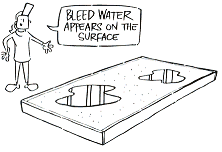
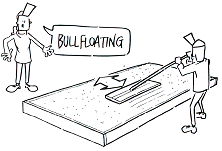
Bleed water will usually appear on the surface of the concrete after the initial screeding. Wait for it to evaporate before final finishing. Do not try to dry up excessive bleed water by using sand or cement as this only weakens the hardened surface. It can be removed by dragging a garden hose across the surface of the concrete.
Applications of Various Finishes
| Finish | Location | Application |
|---|---|---|
| Steel trowel | Inside | Garage, house floors |
| Wood float | Outside | Paths, driveways, entertainment areas, carport floors |
| Broomed | Outside | Sloping paths, driveways, entertainment areas |
| Exposed aggregate | Outside | Sloping paths, driveways, patios, entertainment areas, decorative areas |
Final Finish
Once the concrete can support the weight of a person, leaving only slight surface imprints, the final finishing can begin.
Final finishing involves floating or trowelling the surface of the concrete, jointing and edging. If a special surface finish is required such as a broomed or exposed aggregate finish, this is undertaken at the final finish stage. To select an appropriate finish refer to table above.
Float Finish
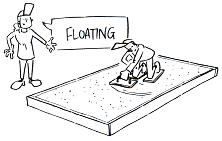
Floats are usually made of timber, trowels of steel. Steel trowels produce a smooth surface finish. Always bear in mind that steel trowelled concrete surfaces can become slippery when wet and are better suited to internal use. Wood floats produce a slightly textured surface finish, are less likely to be slippery when wet and are better suited for external use.
Using either a wood float or steel trowel, place the tool flat on the surface. Incline slightly upwards in the direction of motion. Run the tool smoothly and evenly over the surface of the concrete, right to left in an arc, keeping it slightly inclined in the direction of each motion and moving outwards or inwards to cover the surface.
To produce the desired texture, it may be necessary to trowel the surface a second time after further hardening of the concrete has taken place.
Edge Finishing
An edging tool, which can be purchased from most hardware stores, should be run around the perimeter of the slab adjacent to the formwork to produce a neat, rounded concrete edge finish.
REMEMBER
Keep the edging tool firmly against the formwork to prevent it from biting into the concrete.
Broomed Finishes
Broomed finishes are attractive, slip-resistant textures achieved by PULLING a damp broom across the concrete surface after it has been wood floated or steel trowelled. Coarse textures suitable for steeply sloping paved surfaces are produced by stiff bristle brooms. Medium textures are obtained using soft bristle brooms. For best results, the broom should be rinsed in water after each pass and tapped to remove any excess water.
A broomed texture can be applied in many ways - straight lines, wavy lines. Driveways and paths are normally broomed at right angles to the direction of traffic. Fine to medium broomed textures are commonly used to make slip-resistant surfaces on exterior entertainment areas, garage and shed floors, and gently sloping and flat walking paths and driveways. An edging too should be used to neaten each side of the area that has been broomed.
Exposed Aggregate Finishes
Exposed aggregate finishes also provide an attractive slip-resistant texture and can be achieved either by 'seeding' the surface of the concrete with decorative gravel, or by exposing the structural aggregate used in the concrete.
When 'seeding' the surface, the gravel (usually 20-mm) is scattered evenly over the surface and embedded by trowelling or screeding until just covered with mortar. When the concrete has hardened sufficiently to bear the weight of a person, the stones are exposed by gently water washing and brushing with a stiff nylon broom several times - more vigorously as the concrete hardens.
Alternatively, this method of water washing and brushing can be used to expose the structural aggregate in the slab, but in this case consult us so that an appropriate mix can be supplied.
This finish is best executed by experts and can be achieved over hardened concrete by professionals applying a thin decorative topping slab.
A great finish needs a great start
Call VM Minimix now on
03 9460 4717 for expert advice and prompt, friendly and professional delivery of your pre-mixed concrete.

